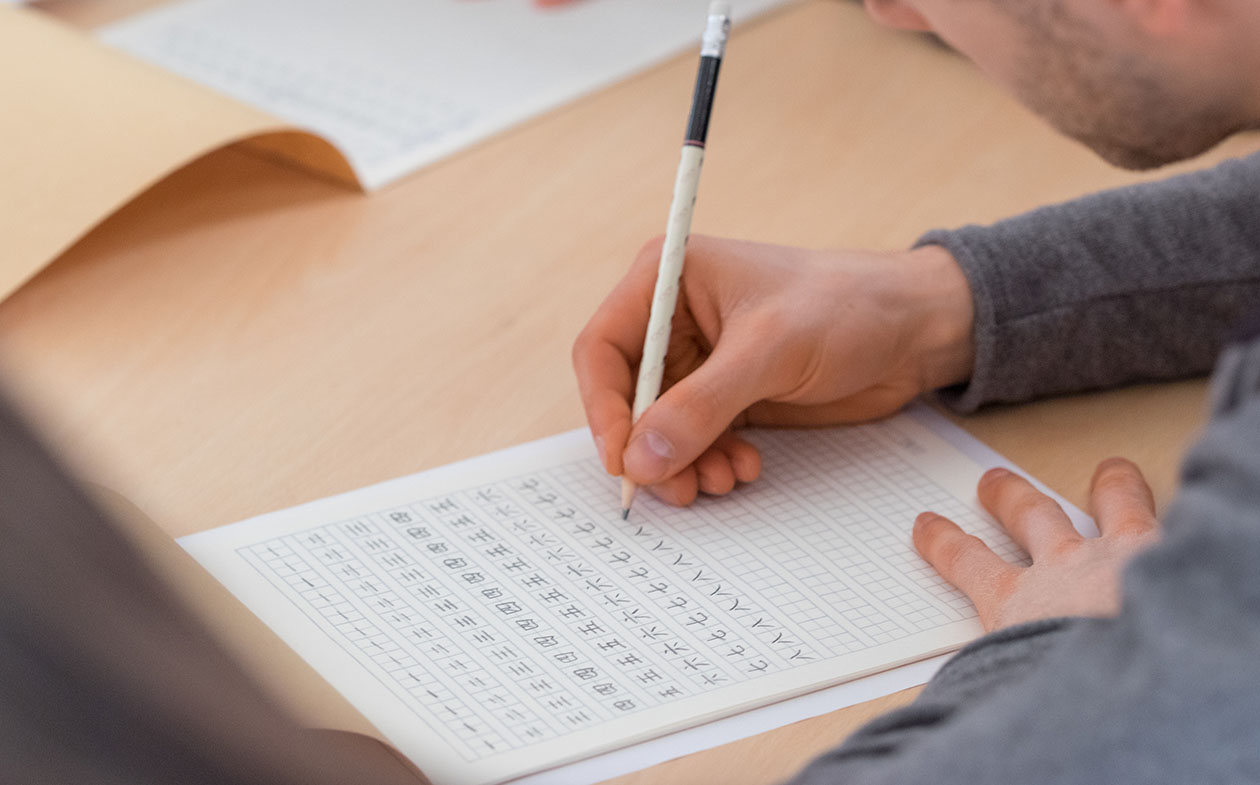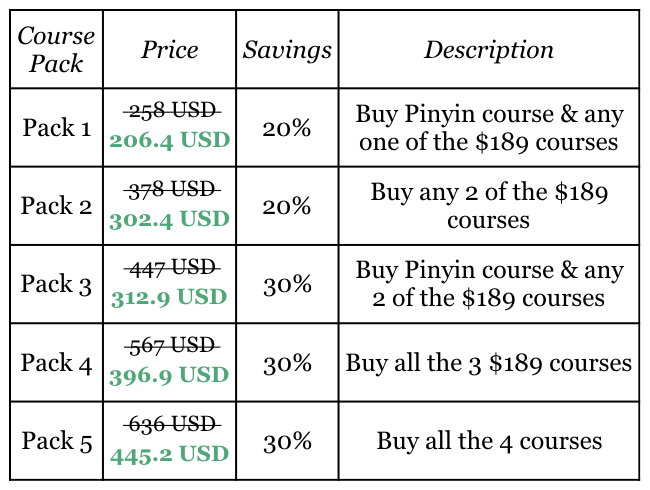Description
WHO IS THIS COURSE FOR?
- This course is for students who want to learn Chinese characters from the very beginning. We start with the absolute basics.
- It’s also suitable for those who have learned some Chinese characters but are still unfamiliar with the whole Chinese character system. This course will help you establish a clear cognitive construct for Chinese characters, which will make your further study much easier and more efficient.
- If you are interested in the origin of each Chinese character, then this course is perfect for you. For most of the Chinese characters in this course, we will explain thoroughly and vividly how they were created, in the process you will learn the real stories behind the characters and some interesting knowledge about Chinese history and culture.
- Those who want to improve their Chinese proficiency while learning Chinese characters should take this course. We always explain and practice the characters in the words, phrases, sentences or even grammar, so it’s not only a Chinese character course, but also a comprehensive Chinese course.
- This course is perfect for people who plan to learn Chinese characters all by themselves or with limited time.
- It will also be a good complement for people who already attend a Chinese class.
- This course focuses on simplified Chinese characters.
HOW IT WORKS?
- Step 1: Watch a video lecture with detailed and clear explanations of each new stroke, character and related words, phrases and sentences.
- Step 2: Use the online or printable flashcards and the audio recording to review what you have learned.
- Step 3: Take the online quiz to check whether you really master all the characters and related knowledge of each lesson.
WAHT AM I GOING TO GET FROM THIS COURSE?
After working through this course, you will be able to read and write 28 Chinese character strokes and 100 commonly used Chinese characters, and recognize approx. 300 related vocabularies and sentences. More importantly, with our clear and systematic instructions you will master the correct way to learn Chinese characters and lay a solid foundation for your future learning.
COURSE CONTENT
Lesson 01 (Please log in to view this sample lesson)
Lesson 02
- The basic stroke “撇piě”
- Six Chinese characters “千 牛 午 生 厂 开” & their origins, stroke order and related vocabularies
- Two sets of Chinese characters that look alike: 午 & 牛, 工 & 土
Lesson 03
- The basic stroke “捺nà”
- Seven Chinese characters “人 八 入 个 大 天 木” & their origins, stroke order and related vocabularies
- Three Chinese characters that look alike: 人 八 入
Lesson 04
- Two basic strokes: the dot stroke “点diǎn” & the rising stroke “提tí”
- Seven Chinese characters “下 六 不 头 少 文 太” & their origins, stroke order and related vocabularies
- Two Chinese characters that look alike: 大 & 太
- Two types of character components and the most correct way to learn Chinese characters
- The water-related character component
- The basic knowledge of Chinese characters: Oracle bone script
Lesson 05
- Two compound strokes begin with “横héng”: 横撇héngpiě & 横钩hénggōu
- Six Chinese characters “又 友 汉 多 买 卖” & their origins, stroke order and related vocabularies and sentences
- Two ways to memorize a Chinese character
- The interesting knowledge of Chinese history: Why do Chinese people call their language and characters “汉语” and “汉字”
Lesson 06
- The compound stroke begins with “横héng”: 横折héngzhé
- Seven Chinese characters “口 中 五 今 右 左 只” & their origins, stroke order and related vocabularies and sentences
- Another way to say “Chinese language”: 中文
- The basic knowledge of Chinese characters: Why does China call itself “中国”
Lesson 07
- The compound stroke begins with “横héng”: 横折钩héngzhégōu
- Ten Chinese characters “书 门 日 月 明 朋 有 田 力 男” & their origins, stroke order and related vocabularies and sentences
- Three characters with the component “月”: 明 朋 有
- The basic knowledge of Chinese characters: Associative characters
Lesson 08
- Two compound strokes begin with “横héng”: 横折提héngzhétí & 横折弯héngzhéwān
- The language/speaking-related character component
- Four Chinese characters “语 话 识 没” & their origins, stroke order and related vocabularies and sentences
- Three meanings of the character “话”
- The basic knowledge of Chinese characters: Associative characters
Lesson 09
- Two compound strokes begin with “横héng”: 横折弯钩héngzhéwāngōu & 横折捺钩héngzhénàgōu
- Five Chinese characters “九 几 飞 风 气” & their origins, stroke order and related vocabularies and sentences
- Two pronunciations of the character “几”
- Two Chinese characters that look alike: 九 & 几
Lesson 10
- Three compound strokes begin with “横héng”: 横折折撇héngzhézhépiě, 横折折折钩héngzhézhézhégōu & 横撇弯钩héngpiěwāngōu
- The walking-related character component and its two written forms
- Two place-related character components
- Seven Chinese characters “这 边 还 场 广 那 哪” & their origins, stroke order and related vocabularies and sentences
- Two pronunciations of the character “还”
- Two Chinese characters that look alike: 广 & 厂
- Two sets of Chinese characters that have the same or similar pronunciations: 厂&场, 那&哪
Lesson 11
- Three compound strokes begin with “竖shù”: 竖折shùzhé, 竖折撇shùzhépiě & 竖折折钩shùzhézhégōu
- Six Chinese characters “山 出 专 马 吗 弟” & their origins, stroke order and related vocabularies and sentences
- Two meanings of the character “马”
- Use the character “吗” to form a Chinese yes-no question
Lesson 12
- Two compound strokes begin with “竖shù”: 竖弯shùwān & 竖弯钩shùwāngōu
- Six Chinese characters “四 西 七 也 儿 说” & their origins, stroke order and related vocabularies and sentences
- Review of the ten Chinese characters for numbers 1~10
- Two Chinese characters that sound similar: 二 & 儿
Lesson 13
- Two compound strokes begin with “竖shù”: 竖钩shùgōu & 竖提shùtí
- Seven Chinese characters “小 可 哥 乐 你 以 长” & their origins, stroke order and related vocabularies and sentences
- Two sets of Chinese antonyms: 多 & 少, 大 & 小
- Three meanings of the character “可”
- Two pronunciations of the character “乐”
Lesson 14
- Two compound strokes begin with “撇piě”: 撇折piězhé & 撇点piědiǎn
- Seven Chinese characters “公 么 什 车 女 妈 奶” & their origins, stroke order and related vocabularies and sentences
- The woman/female-related character component
- The basic knowledge of Chinese characters: Pictophonetic characters
Lesson 15
- Two compound strokes end with “钩gōu”: 弯钩wāngōu & 捺钩nàgōu
- Seven Chinese characters “象 子 了 好 我 民 心” & their origins, stroke order and related vocabularies and sentences
- Two pronunciations of the character “子”
- Three uses of the character “了”
- Three meanings of the character “心”


